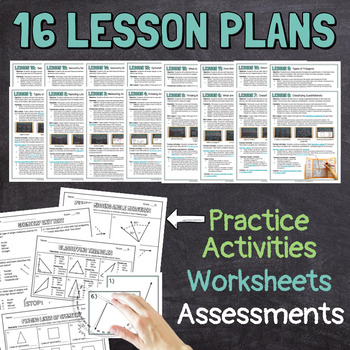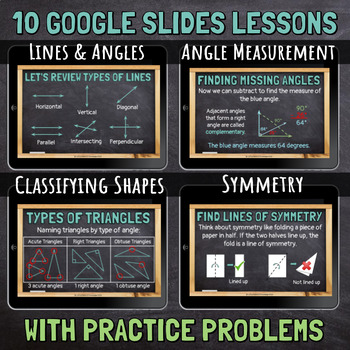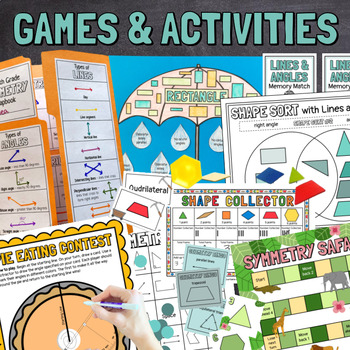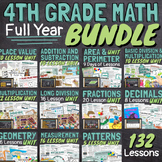4th Grade Geometry 16 Lessons Unit BUNDLE With Slides, Games, Worksheets
- Zip
- Google Apps™

What educators are saying
Products in this Bundle (17)
showing 1-5 of 17 products
Also included in
- This year long fourth grade math bundle includes 132 math lessons spanning 11 different units. All lessons are common core aligned and cover all CCSS standards required for 4th grade math!Begin with each unit guide (these are free and linked below!). The lesson plans will walk you through each unitPrice $156.80Original Price $392.00Save $235.20
Description
This complete geometry math unit includes 16 easy to teach lessons that cover all 4th grade common core geometry standards (including geometric measurement standards).
Skills taught include:
- identifying points, lines, line segments, rays, types of lines (parallel, perpendicular, intersecting), and types of angles (acute, right, obtuse, straight)
- measuring and drawing angles using a protractor
- finding missing angle measures in adjacent angles (including complementary and supplementary angles)
- classifying types of triangles (acute, obtuse, right, equilateral, isosceles, scalene)
- classifying types of quadrilaterals (kite, trapezoid, parallelogram, rhombus, rectangle, square)
- classifying other polygons (pentagon, hexagon, heptagon, octagon, nonagon, decagon)
- regular vs. irregular polygons
- identifying lines of symmetry (symmetrical and asymmetrical shapes)
This unit bundle includes:
- a unit guide with 16 easy to follow lesson plans for each day plus printable worksheets, hands on activities, a unit test assessment, and answer keys
- 235 Google Slides including 10 lessons and tons of practice problems with animated step-by-step solutions
- 5 geometry games
- a geometry lapbook study guide activity
- a Venn diagram shape sorting activity
- a classifying shapes geometry umbrella craft
Please follow my store here for more great resources!
You can also find me on Facebook, Instagram, and lafountaineofknowledge.com where you'll discover ideas, inspiration, and plenty of freebies! Or join my email list to get my monthly newsletter with exclusive FREE resources you can't get anywhere else!
Want free money to spend on Teachers Pay Teachers? Rate this product to earn some TpT credit! Leaving feedback helps us both out and takes less than a minute! Your support makes it possible for me to continue making and sharing great resources! Thank you!






